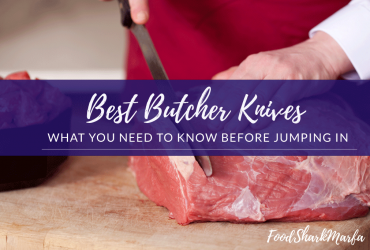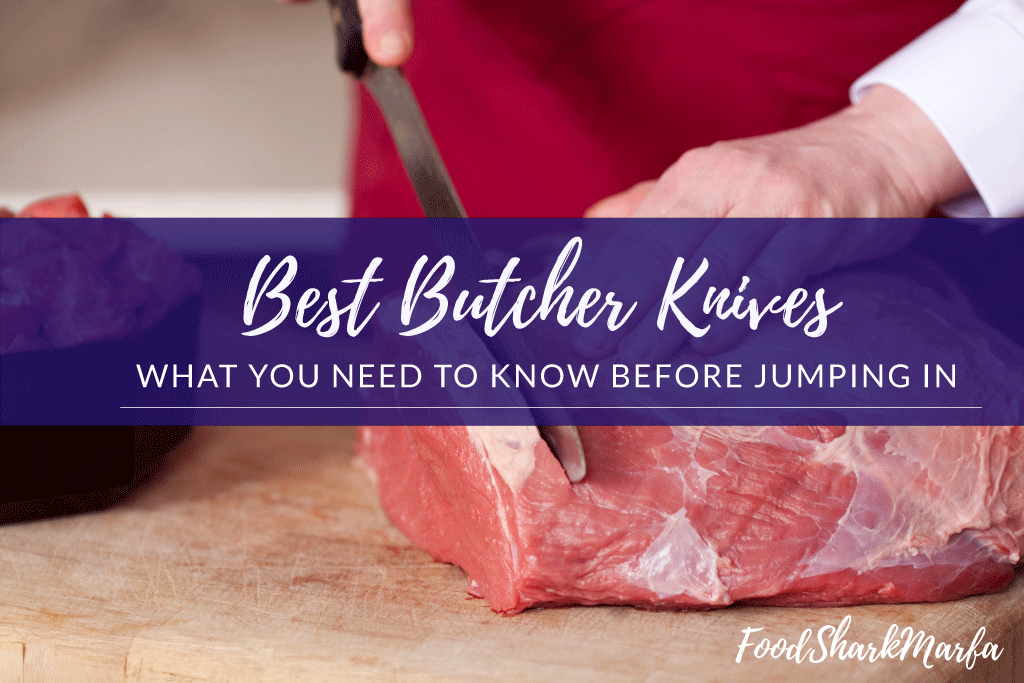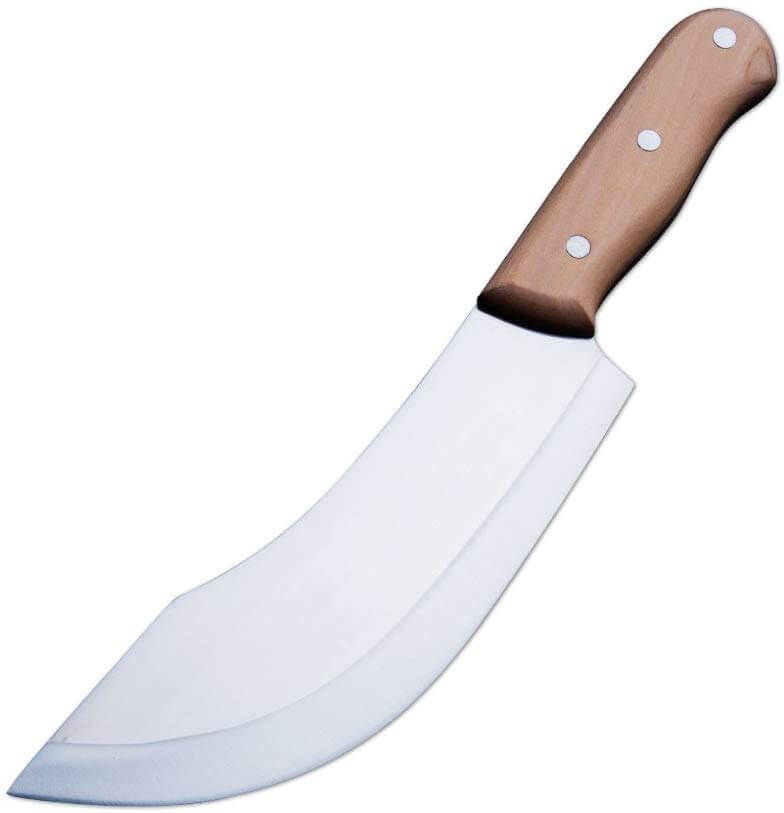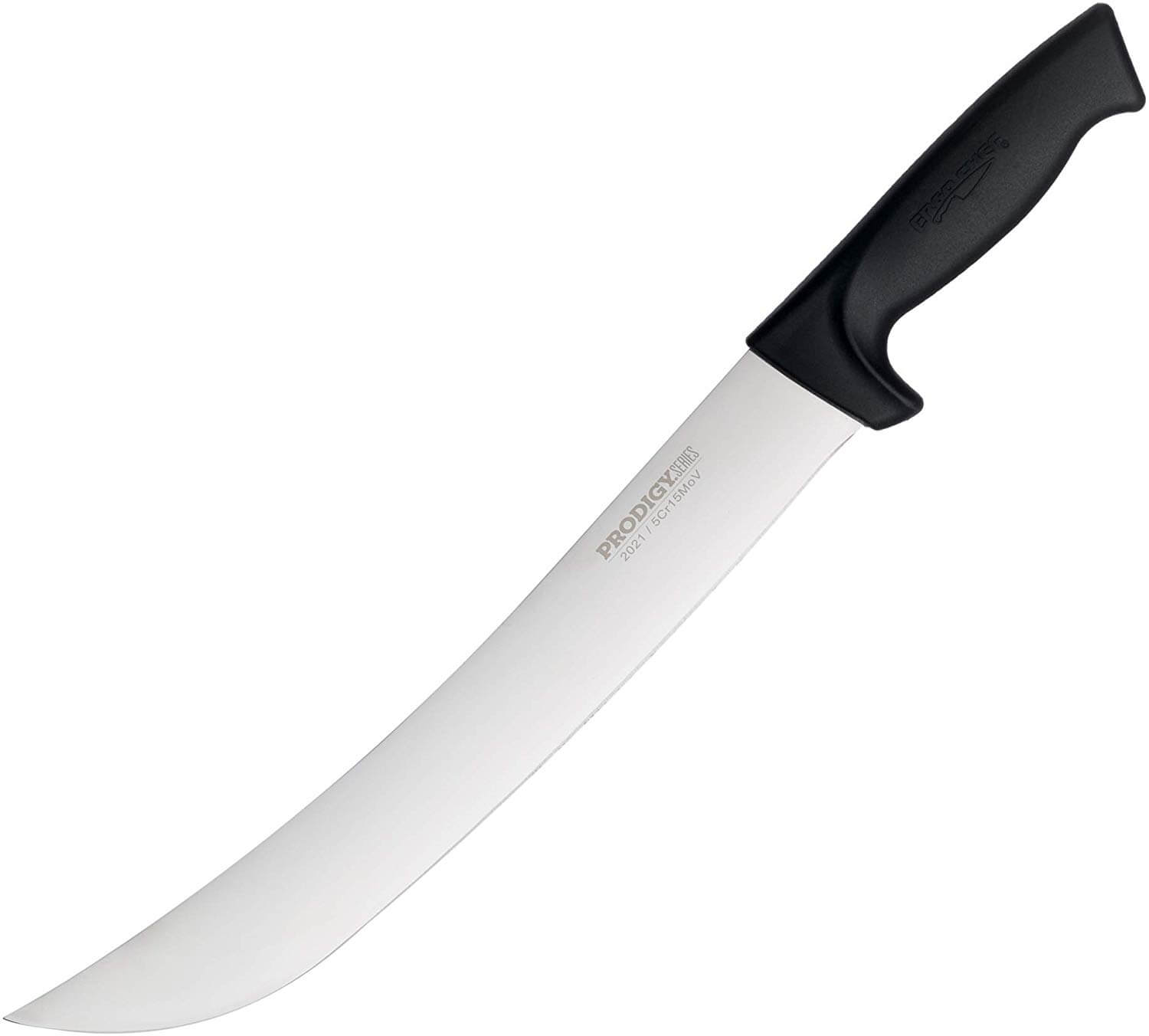If you are a frequent BBQer or just regularly consume meat in your household, then owning a butcher knife will help make light work of those cuts! You may think the rightful place for a butcher knife is in a commercial premises, but this type of knife really does make it much easier to process large cuts and game as not only is it bigger, but it is more robust than a chef’s knife.
A butcher knife is usually straight or curved (cimeter) and available in different lengths. In this review we look at what this means when choosing a butcher knife. We also look at the design and materials of the handle and what type of steel is usually used for the blade. Read on to learn more about the butcher knife and also some of the features of ten of the best butcher knives available across the budget range.Quick Comparison: Top 10 Best Butcher Knives
1. Ontario Knife 7111 Old Hickory Butcher Knife
Made in the US, the Ontario Old Hickory 10" butcher knife has a 1095 high carbon steel blade which is fully heat treated and tempered for cutting edges. The full tang blade is 10" long, making the knife a total length of 15". The hardwood handle is branded ‘Old Hickory’ and riveted with brass.
This straight knife is NSF approved but does not come with a sheath, so you may need to purchase one for safer storage. As this is a high carbon blade, it is more at risk of discoloring with use and will need some extra care after use to minimize the risk of rusting. Using the dishwasher to wash this knife will also increase its risk of rusting.Pros
Cons
2. Rada Cutlery Old Fashioned Butcher Knife
The Rada Cutlery 12⅛" butcher knife has a 7¾" hand sharpened and surgical grade T420 high carbon stainless steel blade and skinning tip. This straight knife has been made in Iowa and comes with a lifetime limited warranty.
Although hand washing is recommended, this knife is dishwasher safe and it has a black resin handle. This does not come with a sheath though, and as a budget friendly butcher knife, its performance may not meet all buyer’s expectations.Pros
Cons
3. DALSTRONG Butcher's Breaking Cimitar Knife
With a hand sharpened Japanese AUS-10V super steel blade, the DALSTRONG Shogun Series 10" professional breaking knife is a full tang blade with a non-slip military grade G-10 handle. The blade is a 62+ Rockwell hardness and a Tsunami Rose blade pattern finish, which may not always be as clear on the blade as advertised, which will disappoint some buyers. This knife also comes with a lifetime limited warranty as well as a satisfaction guarantee.
This cimeter knife has a matching sheath with a pin and string locking mechanism. Some owners consider that the lack of a safety bolster on this knife is problematic; especially those using it in a professional context.Pros
Cons
4. UltraSource 10" Butcher Knife
With NSF certified orange colored antibacterial and textured non-slip handle, the UltraSource 10" butcher knife has a curved blade with a sharp tip and a front and rear safety bolster. The 10" blade is German molybdenum steel which has been cryogenically treated and is versatile enough to handle fish, game and poultry as well as meat slicing. The odd buyer has found that this may not hold an edge as well as may be expected and as a slightly lighter knife it may not suit all users.
Pros
Cons
5. Dexter-Russell S112-10PCP Butcher Knife
The straight edge Dexter Russell 10" butcher knife has a pointed blade tip which has been hand sharpened and hand honed. The blade is stainless S112-10 DEXSTEEL and the handle is white Grip-Tex and is also Sani-Safe. The odd buyer has found this on the long side for more intricate cutting and the blade may not hold an edge for as long as expected. This is not a full tang blade.
Pros
Cons
6. Victorinox Swiss Army Cutlery Fibrox Pro Straight Butcher Knife
The Victorinox 12" butcher knife is a straight and hollow-ground edge knife with a curved tip. This has a Fibrox Pro handle for non-slip gripping even when wet and the handle also has a built-in finger guard. The 12" blade is made from European high carbon steel and has been conical ground and ice tempered for longer lasting sharpness.
This is NSF approved and comes with a lifetime limited warranty. This knife is also dishwasher safe, although hand washing is recommended. As a larger blade this may not be as adept for boning tasks or even working with poultry and smaller meats.Pros
Cons
7. Global GF-27-7 inch, 16cm Heavyweight Butcher's Knife
Made with heavier CROMOVA 18 steel in Japan, the Global 7" heavyweight butcher knife has been face-ground with a long taper edge to help maintain its edge for longer. This is a straight edge knife with a curved tip. This is one piece and seamless, and its hollow stainless steel handle has been molded and dimpled for a safe grip and is filled with a precise amount of sand to give optimum balance.
This is a shorter butcher knife which may not offer as much flexibility with larger joints and it does have a longer handle which may be more cumbersome for some users. This comes with a lifetime limited warranty and should not be cleaned in the dishwasher.Pros
Cons
8. F. Dick Butcher Knife by UltraSource
Made from high carbon stain resistant steel (molybdenum), the F. Dick 10" butcher knife is seamless from the blade to the handle to prevent bacteria from entering the handle. The handle is a blue ErgoGrip handle designed for comfort and non-slip holding. The overall length of this curved knife is 15" and it is NSF certified. As a larger knife this will better suit larger cuts.
Pros
Cons
9. KOFERY 8-Inch Blade Traditional Forged Premium Stainless Steel Kitchen Butcher Knife
The Kofery 8" butcher knife has a partial straight blade with a long curved tip and is designed as a multipurpose knife. This is a full tang forged blade made of stainless steel (4cr13) which attaches to the handle with triple rivets. The wooden handle is a fish belly shape – designed to fit ergonomically into your palm. The wooden handle may not be as well finished as expected and extra care will be needed to keep it at its best. This knife also comes with a satisfaction guarantee.
Pros
Cons
10. Ergo Chef 2021 Prodigy Series Cimeter Curved Breaking Knife & Butcher's Knife
The Ergo Chef Prodigy Series breaking & butcher’s knife has a 12" blade, taking its overall length to 17¼". Designed for butchering larger cuts, this is a cimeter or curved full tang blade stamped from cold-rolled steel with an 18 degree edge. The ergonomic handle is textured for non-slip gripping and it also has a finger guard. This comes with a limited five year warranty against manufacturing defects.
As this is a very long knife, you may need to buy a sheath or specialist storage box or tray as its length will prohibit other types of storage! Its size also means that it is unsuitable for using on smaller cutting tasks. The manufacturer recommends that this knife is hand washed only.Pros
Cons
Things to Consider Before Buying A Butcher Knife
Butcher knives are just as useful for home chefs and BBQers who enjoy cooking meat dishes as for restaurant chefs and butchers. A butcher knife is also useful if you hunt or buy your meat in bulk as it makes for easier processing of the meat and game ready for freezing.
Mainly used for butchering and boning animals, the butcher knife evolved from explorers who lived out in the wilds with the all-purpose knife they used for cutting food, scalping and skinning animals and even for self-defence.
Today’s butcher knives allow us to strip, slice and split meat more efficiently than chef’s knives. The butcher knife is also useful for trimming meat and slicing fat and silverskin – the shiny and thin film on red meat which makes it chewy when cooked. There are other derivatives of butcher knives such as the boning knife, cleaver and carving knife.
A butcher knife has a thicker blade than other types of kitchen knives which helps reduce the risk of it chipping or breaking. Less flexible butcher knives suit chopping and being able to break through the odd bone while a butcher knife with more flex to the blade is useful when working around bones.
The blade length will usually be between five and eight inches, although some may be as short as six inches while others can be as long as 14 inches. For less experienced users, a shorter blade is often better as not only does its shorter length make it easier to handle but it is also more flexible. Smaller blades are also better for getting around bone and processing smaller cuts such as chops and poultry while longer knives are better for larger cuts such as beef and venison.
A butcher knife will usually have a straight or curved (cimeter) blade. When considering knives, cimeter is now the common variant spelling of scimitar - the name for a curved knife.
A straight blade butcher knife is usually easier to use, while the cimeter blade is often more popular for professionals who utilize the curved blade for deboning. As well as the curved or straight blade, there are a range of edges to the blade. Although straight edge is the most common, a serrated blade can be an advantage where you may need to ‘saw’ through meat, while a Granton edge blade can stop meat from sticking to the blade when it needs to be sliced thinly.
Even with a straight blade, the tip of the butcher knife will often be curved to allow you to get the knife between skin and meat and separate it. The curved tip is also useful when removing meat from bone.
Most butcher knives are full tang which means the one piece blade runs (and is visible) through to the butt of the handle and will be riveted in place through the handle. A full tang is often considered to be the most balanced knife which offers more control over tasks and it has a bolster, although it can be heavier which may not suit all users.
There are two main ways to hold a butcher knife safely. The ‘pinch grip’ is where the base is pinched with your first finger and thumb is often the recommended way to hold a butcher’s knife, however, others prefer to wrap their fingers (including the first finger) fully and firmly around the handle. This position also keeps the fingers behind the finger guard which many butcher knives feature.
Types of Handle
The handle of a butcher knife should be comfortable and provide an ergonomic and safe grip, even if the handle is wet or greasy. The weight of the handle should also balance the weight of the knife.
Wooden handle knives are comfortable to hold but they are not as strong as steel handles and can allow bacteria to build up. If you do prefer wood, then regular treating with a food safe mineral oil or an olive oil can help keep natural wood in condition.
Pakkawood is a popular alternative to wood, looking like wood, it will often have distinctive graining. Pakkawood is made from wood which has had a resin added to it to keep the wood resistant to moisture and warping.
Plastic handles are light weight, comfortable and easy to clean and sanitize. These can also be textured for easier gripping. Unfortunately, plastic handles are not always as durable as other materials, so there can be a risk of them breaking over time. Plastic is also more susceptible to damage from temperature extremes.
There are many types of plastics used for butcher knife handles. Some popular choices include Fibrox, which is dishwasher safe, slip resistant and NSF certified. Plastic resins are comfortable to hold and lightweight. Styrene handles are sturdy, lightweight and comfortable to hold while POM or polyoxymethylene is more water and heat resistant than other types of plastic. Polypropylene and nylon handles are often a popular budget option, and both of these are easy to clean.
Although stainless steel is easy to clean and helps balance the weight of a knife, stainless steel handles are not always as comfortable to use, and they can become slippery when wet or greasy.
Many butcher knives will be labelled as NSF certified or NSF safe. This means that the knife meets the requirements of the National Sanitation Foundation or NSF. The NSF is a non-profit formed in 1944 to create food safety and sanitation standards to promote public health.
A product labelled as NSF certified means the manufacturer has only used FDA raw approved materials, the product has passed NSF testing for material design, construction, performance and safety and that it is commercial dishwasher safe and not likely to harbour bacteria. The NSF certification also provides a guarantee that harmful chemicals will not be able to seep into, and contaminate, foods.
The Difference Between Stamped and Forged Steel
A butcher knife will be either stamped or forged steed, a forged blade is often the more popular choice for heavier duty knives. The forged knife usually has a bolster which is the piece of metal between the blade and the handle. The bolster has two functions; the first is to act as a guard to protect our fingers from shifting onto the blade and the second is to balance the weight of the blade as forged blades are usually heavier and/or larger than stamped blades.
The extra weight and size also adds to the extra cost of forged knives, alongside the additional time it takes to make a forged knife.
A forged knife is made by roughly shaping hot steel under a drop hammer which compresses it. Once a basic knife shape has been formed, the knife is then ground and honed into its final shape. A stamped knife is cut from a sheet or steel, usually cold-rolled, with a hydraulic press and this shape, also called a blade blank is then ground and hones to give it its edge.
Edge Retention and Rockwell Hardness
The edge retention refers to how long the blade will keep its edge or stay sharp. A high carbon steel such as 440 or 420 will usually retain its edge longer than stainless steel but stainless steel is easier to sharpen as well as being more resistant to rust and corrosion than high carbon steel.
Stainless steel knives are often made with German steel which is characterized by high carbon. Common German steels include 420, 420HC, 420JC and 440C.
Some manufacturers give a Rockwell hardness rating (RH or RHR) for how hard the blade is. Rockwell is a scale that measures ‘indentation hardness’, and the higher the number, the harder the steel. This means it will keep its edge for longer, but it will also be more brittle and will take longer to sharpen. Although there are different ways of measuring RH, kitchen knives tend to go as high as 60 but those which are nearer 50 will be more forgiving of chips and rougher handling.
Tips for Keeping Your Butcher Knife Looking Its Best
Although a butcher knife may be dishwasher safe, it is usually better to hand wash it, especially if high carbon, as it will increase the risk of rusting as well as damage to the blade.
A butcher knife should always be rinsed immediately after use to stop fat or meat sitting on it for too long. As soon as it is rinsed, dry it off. When you come to wash it properly, use a cloth or sponge and clean it with the cloth or sponge and warm soapy water. If you are uncomfortable with washing it in the water, then you can lay it flat on the countertop, clean one side with the cloth and then turn it over to clean the other. Repeat this wash and then rinse it in warm water and thoroughly dry it.
Always making sure the knife is properly dry after washing will help reduce the risk of rusting, as will storing them on a magnetic or wall rack as this allows air to circulate around them.
If you prefer to use towels instead of paper towels for cleaning down after meat handling, then ensure that the towels and cloths are always washed on a hot cycle in the washing machine.
If your knife has a wooden handle, keep water exposure to a minimum and never leave it soaking in water as this will cause the handle to swell and potentially crack.
If the blade of your butcher knife is rusting, a lubricant such as WD-40 applied to the blade will remove superficial rust. Very rusted knives can be soaked in a mix of citric acid powder and warm water (some suggest one part citric acid to 20 parts water) for a couple of hours to remove the rust. After soaking, there may still be some visible rust, if so, you can use either some fine steel wool or a coarse sponge to try to remove it. If not, you can soak it in a citric acid bath again.
Spraying the blade with oil occasionally will also help it to keep its shine and resistance.
Conclusion
In this review we have looked at why the butcher knife can be useful in the home and what you should look for when selecting one. We have also focused on the importance of handle and blade materials and what NSF certification means when choosing knives. We also looked at blade edges and how the hardness of a blade is measured as well as offering some tips on how to keep your butcher knife looking its best.
We trust that you have enjoyed reading this review and you now feel confident in choosing from the best butcher knives, whether you want a small cimeter blade for preparing poultry for the grill or a large straight blade for tackling a side of beef for the chest freezer!













Related Posts
The 6 Best Watermelon Slicers in 2023
The 12 Best Hard Anodized Cookware Sets in 2023
The 13 Best Chinese Cleavers for Your Kitchen Duties in 2023